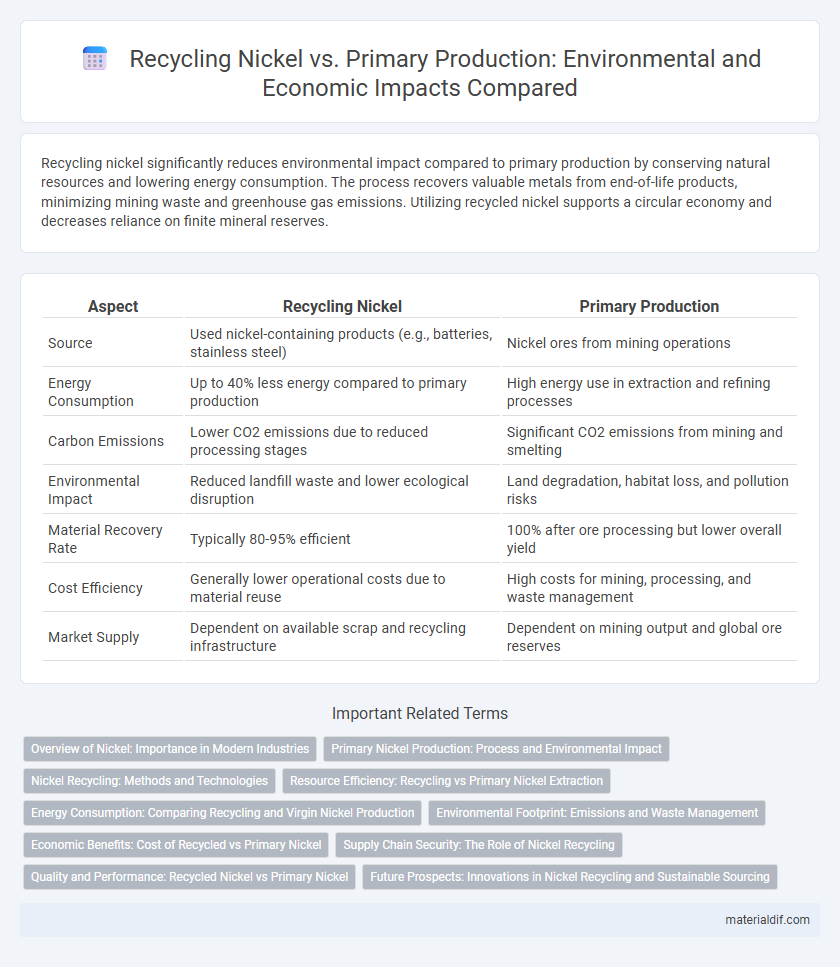Recycling nickel significantly reduces environmental impact compared to primary production by conserving natural resources and lowering energy consumption. The process recovers valuable metals from end-of-life products, minimizing mining waste and greenhouse gas emissions. Utilizing recycled nickel supports a circular economy and decreases reliance on finite mineral reserves.
Table of Comparison
| Aspect | Recycling Nickel | Primary Production |
|---|---|---|
| Source | Used nickel-containing products (e.g., batteries, stainless steel) | Nickel ores from mining operations |
| Energy Consumption | Up to 40% less energy compared to primary production | High energy use in extraction and refining processes |
| Carbon Emissions | Lower CO2 emissions due to reduced processing stages | Significant CO2 emissions from mining and smelting |
| Environmental Impact | Reduced landfill waste and lower ecological disruption | Land degradation, habitat loss, and pollution risks |
| Material Recovery Rate | Typically 80-95% efficient | 100% after ore processing but lower overall yield |
| Cost Efficiency | Generally lower operational costs due to material reuse | High costs for mining, processing, and waste management |
| Market Supply | Dependent on available scrap and recycling infrastructure | Dependent on mining output and global ore reserves |
Overview of Nickel: Importance in Modern Industries
Nickel is a critical metal widely used in stainless steel production, batteries for electric vehicles, and aerospace components due to its corrosion resistance and high strength. Recycling nickel significantly reduces environmental impact and conserves natural resources compared to primary production, which involves energy-intensive mining and refining processes. Increasing demand for sustainable materials drives growth in nickel recycling programs, enhancing supply chain stability and lowering carbon emissions in modern industries.
Primary Nickel Production: Process and Environmental Impact
Primary nickel production involves extracting nickel from laterite and sulfide ores through processes such as pyrometallurgical smelting and hydrometallurgical leaching, which require significant energy consumption and generate greenhouse gas emissions. The environmental impact includes deforestation, habitat destruction, and pollution of air and water resources due to the release of sulfur dioxide and heavy metals during ore processing. Efforts to improve sustainability focus on enhancing process efficiency, waste management, and adopting cleaner technologies to reduce the carbon footprint of nickel production.
Nickel Recycling: Methods and Technologies
Nickel recycling primarily utilizes pyrometallurgical methods such as smelting and refining, and hydrometallurgical processes like solvent extraction and electrowinning to recover high-purity nickel from scrap and spent batteries. Advanced technologies including mechanochemical processing and bioleaching enhance metal recovery efficiency and environmental sustainability by reducing energy consumption and minimizing emissions. Recycling nickel significantly lowers the carbon footprint compared to primary production, contributing to resource conservation and circular economy goals in the stainless steel and battery manufacturing industries.
Resource Efficiency: Recycling vs Primary Nickel Extraction
Recycling nickel significantly reduces energy consumption by up to 40% compared to primary extraction, conserving finite natural resources and minimizing environmental impact. Recycled nickel retains its quality and purity, enabling efficient reuse in stainless steel and battery manufacturing without extensive refining processes. Prioritizing recycling over primary production enhances resource efficiency by lowering greenhouse gas emissions and reducing the demand for mining operations.
Energy Consumption: Comparing Recycling and Virgin Nickel Production
Recycling nickel consumes up to 40% less energy compared to primary production from nickel ore, significantly reducing carbon emissions associated with metal extraction and refining. The energy efficiency of recycling processes stems from bypassing energy-intensive steps like mining, smelting, and refining, which dominate virgin nickel production. Enhanced recycling technologies and increased scrap collection further optimize energy savings, supporting sustainable nickel supply chains.
Environmental Footprint: Emissions and Waste Management
Recycling nickel significantly reduces greenhouse gas emissions by up to 70% compared to primary nickel production, which involves energy-intensive mining and smelting processes. Waste management in recycled nickel is more efficient, generating less hazardous waste and lowering the risk of soil and water contamination. This sustainable approach minimizes the environmental footprint, supporting circular economy initiatives and reducing reliance on finite nickel ore resources.
Economic Benefits: Cost of Recycled vs Primary Nickel
Recycling nickel significantly reduces production costs compared to primary nickel extraction, primarily due to lower energy consumption and reduced raw material expenses. Recycled nickel can decrease manufacturing costs by up to 40%, making it a more economically viable solution in markets sensitive to price fluctuations. The increased demand for nickel in battery production further enhances the financial advantages of recycling over primary mining operations.
Supply Chain Security: The Role of Nickel Recycling
Nickel recycling enhances supply chain security by providing a reliable secondary source that reduces dependency on primary production, which is often concentrated in geopolitically sensitive regions. Recycled nickel requires less energy, lowering carbon emissions and stabilizing market supply against demand fluctuations in stainless steel and battery industries. Integrating recycled nickel strengthens resilience in critical manufacturing sectors by mitigating risks associated with raw material shortages and price volatility.
Quality and Performance: Recycled Nickel vs Primary Nickel
Recycled nickel retains high purity levels, often exceeding 99%, which ensures its performance in critical applications matches that of primary nickel. The recycling process minimizes impurity introduction, preserving the metal's mechanical properties and corrosion resistance vital for industries like stainless steel and battery manufacturing. While primary nickel benefits from consistent ore quality, advances in refining recycled nickel have narrowed the quality gap, making recycled nickel a sustainable and efficient alternative without compromising performance.
Future Prospects: Innovations in Nickel Recycling and Sustainable Sourcing
Innovations in nickel recycling technology, such as hydrometallurgical processes and bioleaching, are improving recovery rates and reducing environmental impact, positioning recycled nickel as a viable alternative to primary production. Sustainable sourcing initiatives focus on responsible mining practices and increasing the supply of recycled nickel to meet growing demand in electric vehicle batteries and renewable energy storage. Future prospects emphasize circular economy models that integrate efficient recycling systems to minimize reliance on virgin nickel ores and enhance resource security.
Recycling Nickel vs Primary Production Infographic

 materialdif.com
materialdif.com